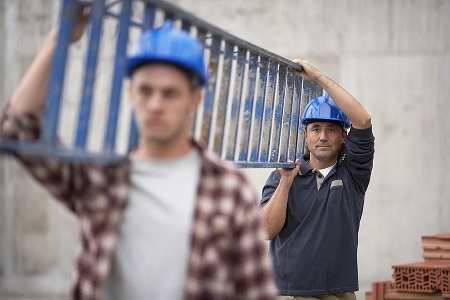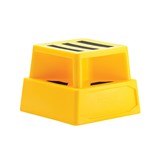The following guidelines highlight what equipment is needed in different situations.
0 to 7 degrees
When dealing with this small of an incline to a roof, a walkway should be 600mm wide. It can be made from steel or aluminium, but needs to be mounted onto support brackets. The downward pressure on this type of a walkway can cause flexing; adhere to manufacturer recommendations or walkways can dislodge from their mounts.
From 7 to 20 degrees
When the grade reaches up to 20 degrees, the Standard requires a cleated or grated walkway. Spacing between cleats varies based on the angle of the walkway, but a square bar must be built into the walk to improve footing. As inclines become more severe, handrails are also advised. They aren't included in the current Standard, but guardrails are listed in other legislation. They are simply a smart component of risk management.
From 20 to 26.5 degrees
This incline is too steep for a standard walkway, but not step enough to allow a staircase. As an alternative, the Standard calls for steps with intermittent landings.
From 26.5 to 45 degrees
This grade makes a staircase the preferred option. A ladder should only be used if space constraints make stairs architecturally infeasible.
From 45 to 60 degrees
The Standard calls this the "danger zone". Access equipment should not be installed or used.
From 60 to 70 degrees
Step ladders are the preferred option for this slope. They should include treads and handrails.
Step ladders are preferable because they offer better stability and balance than rung ladders. The steps are broader and it is difficult to fall backwards from a step ladder.
From 70 to 90 degrees
With this steep of an incline rung ladders need to be installed. They should be installed at a 75 degree angle, if possible, and intermediate landing platforms are required above certain heights.
Some conditions also require cages to be installed, providing a stable place to rest. When rung ladders are needed, ladder safety lines can be an effective safeguard. The user attaches a safety harness with a locking mechanism to steel cables incorporated in the ladder.
Safety lines are hardly fail-proof, and one can still be injured or experience suspension trauma, but this is preferable to a significant fall. Users need to be trained and equipment must be regularly maintained and tested.
Non-compliance with this section of the Standard simply isn't an option. With the inherent risk of injury from ladder use, risk managers need to take the time to ensure the right equipment is purchased and properly installed.



